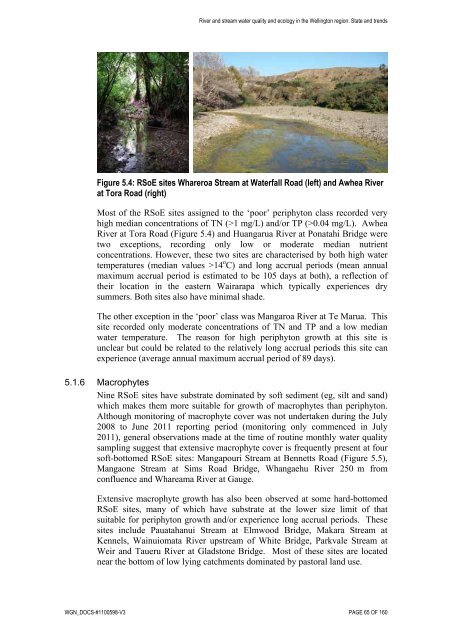River and stream water quality and ecology - Greater Wellington ...
River and stream water quality and ecology - Greater Wellington ...
River and stream water quality and ecology - Greater Wellington ...
You also want an ePaper? Increase the reach of your titles
YUMPU automatically turns print PDFs into web optimized ePapers that Google loves.
<strong>River</strong> <strong>and</strong> <strong>stream</strong> <strong>water</strong> <strong>quality</strong> <strong>and</strong> <strong>ecology</strong> in the <strong>Wellington</strong> region: State <strong>and</strong> trends<br />
Figure 5.4: RSoE sites Whareroa Stream at Waterfall Road (left) <strong>and</strong> Awhea <strong>River</strong><br />
at Tora Road (right)<br />
Most of the RSoE sites assigned to the ‘poor’ periphyton class recorded very<br />
high median concentrations of TN (>1 mg/L) <strong>and</strong>/or TP (>0.04 mg/L). Awhea<br />
<strong>River</strong> at Tora Road (Figure 5.4) <strong>and</strong> Huangarua <strong>River</strong> at Ponatahi Bridge were<br />
two exceptions, recording only low or moderate median nutrient<br />
concentrations. However, these two sites are characterised by both high <strong>water</strong><br />
temperatures (median values >14 o C) <strong>and</strong> long accrual periods (mean annual<br />
maximum accrual period is estimated to be 105 days at both), a reflection of<br />
their location in the eastern Wairarapa which typically experiences dry<br />
summers. Both sites also have minimal shade.<br />
The other exception in the ‘poor’ class was Mangaroa <strong>River</strong> at Te Marua. This<br />
site recorded only moderate concentrations of TN <strong>and</strong> TP <strong>and</strong> a low median<br />
<strong>water</strong> temperature. The reason for high periphyton growth at this site is<br />
unclear but could be related to the relatively long accrual periods this site can<br />
experience (average annual maximum accrual period of 89 days).<br />
5.1.6 Macrophytes<br />
Nine RSoE sites have substrate dominated by soft sediment (eg, silt <strong>and</strong> s<strong>and</strong>)<br />
which makes them more suitable for growth of macrophytes than periphyton.<br />
Although monitoring of macrophyte cover was not undertaken during the July<br />
2008 to June 2011 reporting period (monitoring only commenced in July<br />
2011), general observations made at the time of routine monthly <strong>water</strong> <strong>quality</strong><br />
sampling suggest that extensive macrophyte cover is frequently present at four<br />
soft-bottomed RSoE sites: Mangapouri Stream at Bennetts Road (Figure 5.5),<br />
Mangaone Stream at Sims Road Bridge, Whangaehu <strong>River</strong> 250 m from<br />
confluence <strong>and</strong> Whareama <strong>River</strong> at Gauge.<br />
Extensive macrophyte growth has also been observed at some hard-bottomed<br />
RSoE sites, many of which have substrate at the lower size limit of that<br />
suitable for periphyton growth <strong>and</strong>/or experience long accrual periods. These<br />
sites include Pauatahanui Stream at Elmwood Bridge, Makara Stream at<br />
Kennels, Wainuiomata <strong>River</strong> up<strong>stream</strong> of White Bridge, Parkvale Stream at<br />
Weir <strong>and</strong> Taueru <strong>River</strong> at Gladstone Bridge. Most of these sites are located<br />
near the bottom of low lying catchments dominated by pastoral l<strong>and</strong> use.<br />
WGN_DOCS-#1100598-V3 PAGE 65 OF 160
















